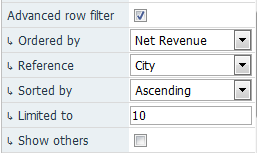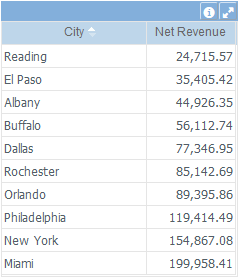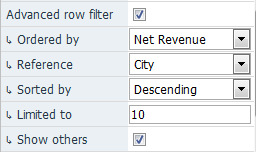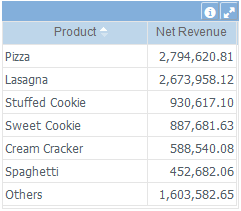Difference between revisions of "Advanced row filter"
(Created page with "Creates a dinamic dataset that is used as a filter in the object. Question: I want to filter the 10 greater clients by gross sales. For basic row limits, see [[Row limit...") |
|||
| (11 intermediate revisions by 4 users not shown) | |||
| Line 1: | Line 1: | ||
| − | + | <languages/> | |
| + | <translate> | ||
| + | <!--T:1--> | ||
| + | Define a dynamic dataset that is used as a '''filter''' for the data in the object. | ||
| − | + | <!--T:2--> | |
| + | The data displayed in the object can be different from the columns used to create the dataset. You can create a dynamic dataset that brings the ''top ten clients by gross sales'' value and see in the object which products these ''clients'' buy. The data of the dynamic dataset does not necessarily need to be explicitly shown in the object. | ||
| + | |||
| + | <!--T:3--> | ||
| + | For basic row limits, see [[Row limit]]. | ||
| + | |||
| + | |||
| + | <!--T:4--> | ||
| + | '''Parameters''' | ||
| + | |||
| + | <!--T:5--> | ||
| + | * Ordered by: Set the ''Value'' column that will be used to filter the results for the dataset; | ||
| + | * Reference (Grouped by): Set the ''Text'' or ''Date'' column that will be used to group the dataset; | ||
| + | * Sorted by: Set if the filter of the dataset will get the greater (Descending) or smaller (Ascending) results; | ||
| + | * Limited to: Set a number of rows that the dataset will bring; | ||
| + | * Show others: Set if the remaining rows (not contained in the dataset) will be aggregated under an ''Others'' row. | ||
| + | <!--T:6--> | ||
| + | To facilitate its use, think about the parameters as a question: | ||
| − | |||
| + | <!--T:7--> | ||
| + | ''I want to filter the object data by the '''[Limited to]''' '''[Sorted by]''' '''[Grouped by]''' by '''[Ordered by]'''.'' | ||
| − | + | <!--T:8--> | |
| + | or | ||
| − | + | <!--T:9--> | |
| − | + | ''I want to filter the object data by the '''[10]''' '''[greater]''' '''[clients]''' by '''[gross sales]'''.'' | |
| − | |||
| − | |||
| − | |||
| + | <!--T:10--> | ||
'''Example''' | '''Example''' | ||
| + | |||
| + | <!--T:11--> | ||
| + | 1) Filter by and show the ''10 smaller cities'' by ''net revenue'': | ||
| + | |||
| + | <!--T:12--> | ||
| + | Advanced row filter parameters: | ||
| + | |||
| + | <!--T:13--> | ||
| + | [[File:Filtro Avançado de linhas 1+en-US.PNG]] | ||
| + | |||
| + | <!--T:14--> | ||
| + | Result: | ||
| + | |||
| + | <!--T:15--> | ||
| + | [[File:Filtro Avançado de linhas 2+en-US.PNG]] | ||
| + | |||
| + | <!--T:16--> | ||
| + | In this case, the result dataset is being shown directly on the object. | ||
| + | |||
| + | |||
| + | |||
| + | <!--T:17--> | ||
| + | 2) Filter by the ''10 greater cities'' by ''net revenue'' and show the product sales distribution is these cities: | ||
| + | |||
| + | <!--T:18--> | ||
| + | Advanced row filter parameters: | ||
| + | |||
| + | <!--T:19--> | ||
| + | [[File:Filtro Avançado de linhas 3+en-US.PNG]] | ||
| + | |||
| + | <!--T:20--> | ||
| + | Result: | ||
| + | |||
| + | <!--T:21--> | ||
| + | [[File:Filtro Avançado de linhas 4+en-US.PNG]] | ||
| + | |||
| + | <!--T:22--> | ||
| + | In this case, the result dataset is being used to filter the product sales in these cities (10 greatest). | ||
| + | |||
| + | <!--T:23--> | ||
| + | The total amount of sales in the other cities are grouped under the ''Others'' rows. This row shows the other cities amount, not the other products. | ||
| + | |||
| + | <!--T:24--> | ||
'''Applies to''' | '''Applies to''' | ||
| + | <!--T:25--> | ||
[[Table]], [[Cross Table]], [[Column Chart]], [[Bar Chart]], [[Line Chart]], [[Area Chart]], [[Pie Chart]], [[Cross Column Chart]], [[Cross Bar Chart]], [[Cross Line Chart]], [[Cross Area Chart]], [[Combo (Filter)]] | [[Table]], [[Cross Table]], [[Column Chart]], [[Bar Chart]], [[Line Chart]], [[Area Chart]], [[Pie Chart]], [[Cross Column Chart]], [[Cross Bar Chart]], [[Cross Line Chart]], [[Cross Area Chart]], [[Combo (Filter)]] | ||
| + | </translate> | ||
Latest revision as of 19:03, 18 September 2017
Define a dynamic dataset that is used as a filter for the data in the object.
The data displayed in the object can be different from the columns used to create the dataset. You can create a dynamic dataset that brings the top ten clients by gross sales value and see in the object which products these clients buy. The data of the dynamic dataset does not necessarily need to be explicitly shown in the object.
For basic row limits, see Row limit.
Parameters
- Ordered by: Set the Value column that will be used to filter the results for the dataset;
- Reference (Grouped by): Set the Text or Date column that will be used to group the dataset;
- Sorted by: Set if the filter of the dataset will get the greater (Descending) or smaller (Ascending) results;
- Limited to: Set a number of rows that the dataset will bring;
- Show others: Set if the remaining rows (not contained in the dataset) will be aggregated under an Others row.
To facilitate its use, think about the parameters as a question:
I want to filter the object data by the [Limited to] [Sorted by] [Grouped by] by [Ordered by].
or
I want to filter the object data by the [10] [greater] [clients] by [gross sales].
Example
1) Filter by and show the 10 smaller cities by net revenue:
Advanced row filter parameters:
Result:
In this case, the result dataset is being shown directly on the object.
2) Filter by the 10 greater cities by net revenue and show the product sales distribution is these cities:
Advanced row filter parameters:
Result:
In this case, the result dataset is being used to filter the product sales in these cities (10 greatest).
The total amount of sales in the other cities are grouped under the Others rows. This row shows the other cities amount, not the other products.
Applies to
Table, Cross Table, Column Chart, Bar Chart, Line Chart, Area Chart, Pie Chart, Cross Column Chart, Cross Bar Chart, Cross Line Chart, Cross Area Chart, Combo (Filter)



